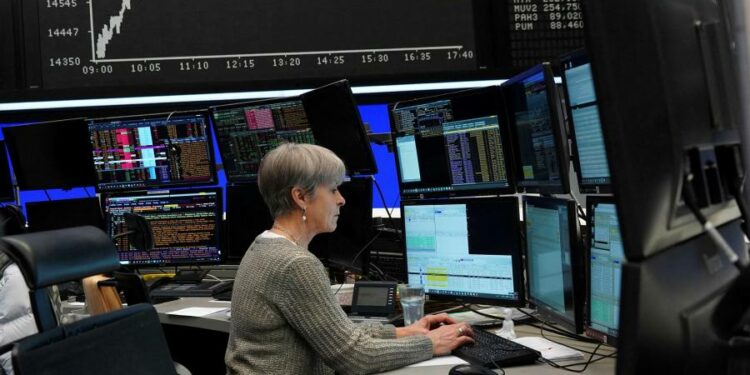European stocks and US futures edged higher, after days of sharp swings, reflecting uncertainty over whether Russia would escalate its assault on Ukrainian territory and the likely impact of western sanctions.
The regional Stoxx 600 share index was up 0.6 per cent by midday in London, after skirting a technical correction, defined as a 10 per cent drop from a recent peak, in the previous session.
Futures markets implied Wall Street’s S&P 500 would gain 0.6 per cent in early New York dealings. The gauge had entered its own correction on Tuesday as the US launched a wave of sanctions against Russia and President Joe Biden accused his Russian counterpart Vladimir Putin of beginning an “invasion” of Ukraine.
Germany’s Xetra Dax added 0.6 per cent and London’s FTSE 100 gained 0.4 per cent.
Volatility indices remained elevated, however, indicating that the latest rally may not hold.
Stock markets, government bonds and oil prices have traded choppily all week as Putin put his country on a war footing, endorsing claims of Russia-backed separatists to the entire Donbas region of eastern Ukraine and western powers responded by rolling out sanctions.
“We have a lot of volatility so what we’re seeing now is stabilisation after a big drop,” said Nadège Dufossé, head of cross-asset strategy at Candriam. “Investor sentiment had become extremely pessimistic, so that’s a contrarian signal and means that a lot of the downside risk has been integrated.”
The Vix, a measure of expected volatility on the S&P 500, traded at 28.4, above its long-run average of about 20. The equivalent European index was also elevated at 31.
On Tuesday, Germany halted certification of the Nord Stream 2 Russian gas pipeline, while Biden said the US had cut Russia off from western financing and announced measures to target two of the nation’s largest financial institutions.
The move helped to propel Brent crude, the international oil benchmark, to a high of $99.50 a barrel as traders also grappled with the possibility of disrupted supply from Russia. On Wednesday, Brent fell 0.4 per cent to $96.49 but the marker remained about 3 per cent higher so far this week.
Andreas Billmeier, European economist at Western Asset Management, added that markets were showing “some relief” that sanctions levelled at Russia “so far” would not disrupt the global economy.
“It could have been worse, for example by taking Russia out of Swift,” he said, referring to the international payments system that underpins trillions of dollars worth of transactions each year.
The yield on the 10-year US Treasury note rose 0.02 percentage points to 1.97 per cent as the low-risk debt instrument fell in price, signalling an improvement in equity market sentiment on Wednesday.
The dollar index, which measures the US currency against six others, edged 0.1 per cent lower.
Spot gold, a popular investment during heightened geopolitical tensions, fell 0.2 per cent to $1,894 an ounce.











